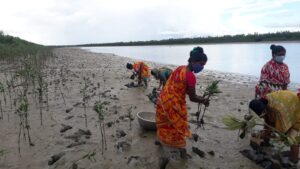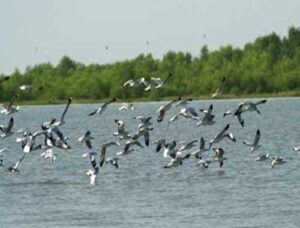

Save the Endangered Mangrove, the Protectors of Sunderban
For generations, mangroves have acted as a crucial barrier between coastal area and cyclones, flooding, coastal soil erosion while providing livelihoods for communities around it. Mangrove is a shrub type of plant having a density of 25 trees per 25 square feet, too deep to explore. As per the experts, without the mangroves, the ecosystem would simply die out. In the case of the Sundarbans, this includes close to 4.5 million people, and a large number of rare and globally threatened species.
Damages done by Cyclone Amphan to the Mangrove:

Almost 70% of the mangrove forest had been ruined by Amphan. The severe cyclone with the wind speed of 280km/hr. has burnt the trees by permanently damaging the Xylem tissue. Amphan broke hundreds of branches but astonishingly could not uproot them.

Surrounded by mangroves, the Sunderbans offer habitat to a variety of species like crabs, small fishes, shrimps and more. Other than these, one can spot fauna like wild boars, fishing cats, macaques, common grey mongoose, fox, jungle cats, flying fox, pangolins, spotted deer and The Royal Bengal Tiger at the Sunderbans. Along with these animals, Mangrove is also home for millions of birds, snakes and insects. Fishes like “Tangrul” lives in this forest region by making holes in the soil. These species are in danger too as they have lost their homes and babies.

People of Sunderban are also economically dependent on the Mangrove forest resources. Villagers go to the deep forest to collect honey and shrimp. They make fuels out of the branches, furniture from the wood and so on. This population is equally threatened by Amphan.
How Mukti is working to preserve the eco-system of the forest:
The entire eco-system of Sunderban depends on Mangrove. So, by saving the Mangrove, nature will automatically conserve the eco- system. Mangroves grow naturally from the fallen seeds of the fruits. But, this time the devastation is so deadly that Mangrove needs human help for survival.

Mukti has selected 6 blocks under its action area – Mathurapur Block II, Pathapratima, Kultali, Sagar, Namkhana, Kakdwip to plant Mangrove saplings beside the river bank. The project will cover around 100 hectors (20-25 hectors in each block) of forest area. The saplings of Sundori, Goran , Geyoya, Bani, Khagra, Keyora etc will be planted. Mukti has planted 10 saplings in 10 square feet. It will take 10-12 years to mature the trees fully.
At very initial stage Mukti has planted 10-12 (among 1 lakh) Mangrove saplings at Mathurapur Block II beside the bank of river “Muni”. Mukti collected the seeds (from the fallen fruits) from the river banks, nurture them and then plant them.
Mukti has engaged 100 women workers under “Food for Work” project to plant the saplings. They will receive dry rations and some money from Mukti for the same.
A ray of hope in the destruction:

Nature has its own process of restoration. New leaves are announcing their arrival from the broken branches. The birds flown away are coming back to their homes.
Mukti is hopeful to restore their homes, the Mangrove forest to the animals who got homeless after Amphan, hopeful to back nature to its past days and hopeful that people will be soon able to start their livelihood who depends on the Mangrove.
Mukti wishes all your support to save the Mangrove so as to save the Sunderban.
[gdlr_button href=”http://localhost/mukti-old/product/donate-amphan” target=”_self” size=”medium” background= “#FF0000″ color=”#ffffff”] Donate Now! [/gdlr_button]
Project Activities
- A village for independent and enterprising women (A VIEW) (5)
- About Mukti (4)
- Accreditation (14)
- AGM (63)
- Agriculture Reforms (123)
- Ambulance Service (2)
- Amplifying Community Voices (67)
- Awards (15)
- Awareness and Empowerment (132)
- Awareness drives (56)
- Bio-Village-Kankandighi (10)
- Careers (14)
- Chick Rearing Programme for Marginalised Women (16)
- CHILD (18)
- Climate Resilience River Embankment (46)
- Covid-19 (74)
- Cultural Shows (7)
- Cyclone Aila (13)
- Cyclone Amphan (44)
- Cyclone Bulbul (30)
- Cyclone Dana (3)
- Cyclone Remal (12)
- Cyclone Response & Recovery (90)
- Cyclone Tolerant Houses (15)
- Cyclone Yaas (57)
- Disaster Recovery (264)
- Editorial (55)
- Editorial by Abir Biswas (1)
- Editorial by Amit Kumar Dey (2)
- Editorial by Ananya Chatterjee (3)
- Editorial by Ankita Kothiyal (3)
- Editorial by Debabrata Halder (1)
- Editorial by Dr. Alokananda Ghosh Sengupta (2)
- Editorial by Kasturi Bakshi (1)
- Editorial by Monami Mitra (1)
- Editorial by Nandita (3)
- Editorial by Pampa Karmakar (1)
- Editorial by Pranay Patra (1)
- Editorial by Prof. Pradeep Ray (1)
- Editorial by Ranitendranath Tagore (1)
- Editorial by Sankar Halder (14)
- Editorial by Satyajit Ray (7)
- Editorial by Sohini Mehta (1)
- Editorial by Sonamon Basu (3)
- Editorial by Soumitra Bose (2)
- Editorial by Subhankar Basu (1)
- Editorial by Supriyo Banerjee (3)
- Editorial by Ujjwal Maity (2)
- Education and Enrichment (409)
- Environment and Resilience (127)
- Featured Activities (24)
- Gram Clinic (9)
- Health Water & Sanitation (95)
- HOPE (10)
- Impact Stories List (109)
- Integrated Development (210)
- International Management Institute (IMI) (2)
- Jal hi Kal (6)
- Kitchen Gardening (16)
- Livelihood & Enablement (218)
- MCDF (119)
- Medical Camp (44)
- MIT (8)
- MKSS (49)
- MSS (142)
- Mukti Academia (5)
- Mukti Academy (2)
- Mukti Craft (17)
- Mukti Cultural (2)
- Mukti Employment Exchange (MEE) (9)
- Mukti Fresh (15)
- Mukti Gram - Egra (11)
- Mukti Gram - Purbashridharpur (170)
- Mukti Green Defense in Sundarbans (11)
- Mukti Yoga (12)
- Mukto Dhara (2)
- Northumbria University (2)
- Obituary (6)
- Observance Days Celebration (53)
- Organic Farming & Training Support (45)
- Pond Rejuvenation (20)
- Prerana (1)
- Prerna (4)
- Projects For Mukti Wide (7)
- Queen Mary University of London (1)
- Rights and Special Needs (113)
- Run for Cause (13)
- Run4SafeFood (7)
- SDF (6)
- Shahoshini (9)
- Skill & Enterprise Development (21)
- Smart lab (5)
- Social Stock Exchange (2)
- Social Workers' Convention (1)
- Sundarbans Green (SUN-G) (15)
- Sunderban development fair project (4)
- Surya (12)
- Sustainable Agriculture Movement (62)
- SWAS-2-0 (18)
- Swastha Shongini (32)
- Swavalamban Accelerator in Sundarbans (SWAS) (21)
- Tour for Cause (45)
- TSS (195)
- UDAAN (7)
- Uncategorized (99)
- University of Calcutta (1)
- Value Education (12)
- Valued Partners (3)
- Vocational Trainings (15)
- VOICE (14)